- North Korea
- Ian Munro
- ARD Competition
- Ron Butlin
- Nabil Benabdeljalil: En attente du printemps
- Luca Attilii
- Nicholas Childs
- Friends of Music
 DISCUSSION: John Dante Prevedini leads a discussion about Classical Music and Politics, including contributions from Béla Hartmann and James Ross.
DISCUSSION: John Dante Prevedini leads a discussion about Classical Music and Politics, including contributions from Béla Hartmann and James Ross.
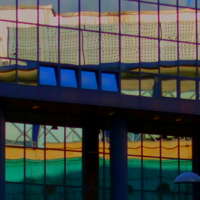 CENTRAL ENGLAND: Mike Wheeler's concert reviews from Nottingham and Derbyshire feature high profile artists on the UK circuit - often quite early on their tours.
CENTRAL ENGLAND: Mike Wheeler's concert reviews from Nottingham and Derbyshire feature high profile artists on the UK circuit - often quite early on their tours.
On the Day of the Dead
RON BIERMAN reports from San Diego on Gabriela Lena Frank's opera 'El último sueño de Frida y Diego'
The San Diego Opera, reveling in modern fantasies, has followed its successful production of Aging Magician with El último sueño de Frida y Diego (The Last Dream of Frida and Diego). The former featured a mysterious chorus commenting cryptically on the everyday actions of its maybe dying main character who, maybe while dying, ascends to join the chorus in a brilliantly staged finale. The more recent production is less ambiguous, but even more phantasmagoric. Semi-reality shares the stage with an underworld of the dead as Frida (mezzo-soprano Guadalupe Paz) decides whether to accept a one-day pass back to life, and Diego (baritone Alfredo Daza) laments his lost love.

Guadalupe Paz. Photo © Karli Cadel
Written by Gabriella Lena Frank and Pulitzer Prize-winning playwright-librettist Nilo Cruz, the opera is based on the wildly passionate love affair of Frida Kahlo and Diego Rivera. Selma Hayek and Antonio Banderas recreate the couple's stormy relationship in the 2002 film Frida. How stormy? In 1925, Frida was in a traumatic accident that resulted in painful injuries she suffered with for the rest of her life. She was once quoted as saying: 'There have been two great accidents in my life. One was the trolley, and the other was Diego. Diego was by far the worst.'
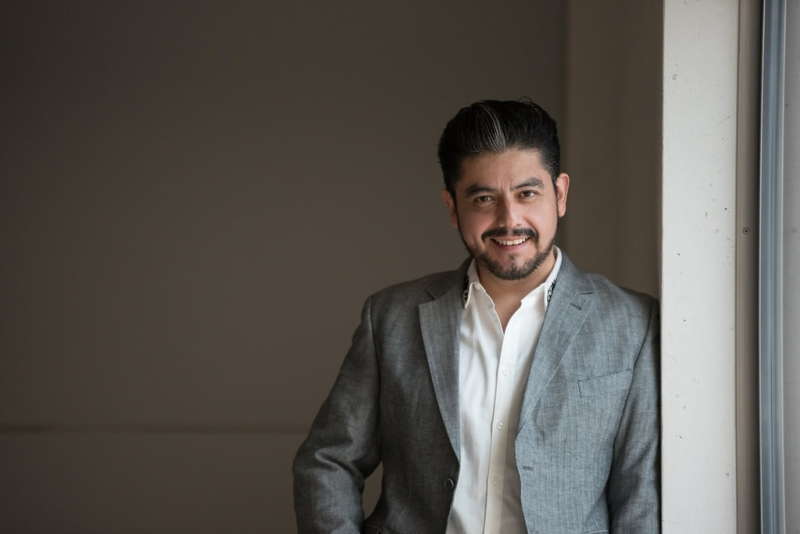
Alfredo Daza. Photo © Karli Cadel
Librettist Cruz concentrates on the couple's tenuously enduring love for each other, their fights and frequent extra-marital affairs touched upon only lightly to explain Frida's reluctance for another day with Diego. (Even Frida's notorius fling with Russian revolutionary Leon Trotsky goes unmentioned.)
Cruz sets the opera on Mexico's Dia de los Muertos (Day of the Dead) shortly before Diego's death and a few years after Frida's. The curtain rises on a cemetery. As graveside visitors, the versatile and effective San Diego Opera Chorus sets a somber mood with dirge-like melodies, Diego wanders among the singers while Frank's ominous score competes with the eeriest of horror-film soundtracks. Soprano Maria Katzarava as Catrina, keeper of souls in the underworld, is disguised as a flower seller when she observes Diego's emotional turmoil.
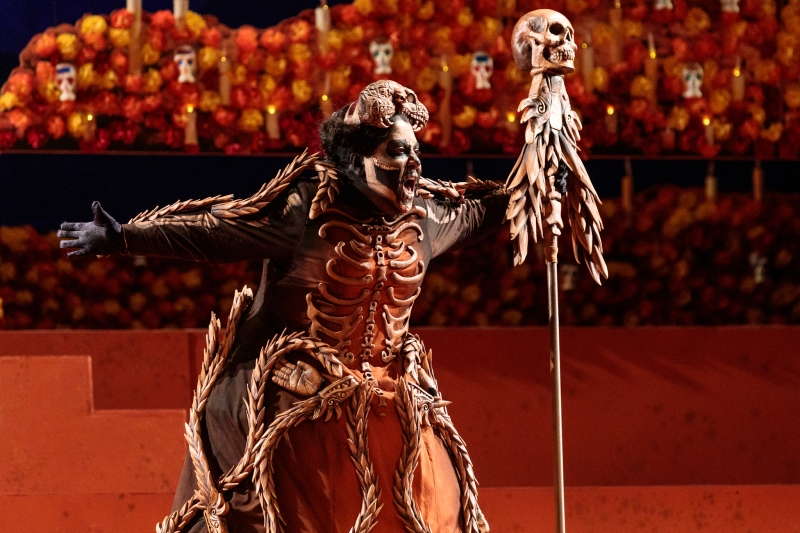
Maria Katzarava as Catrina. Photo © Karli Cadel
He thinks of Frida and contemplates his own death in a mournful aria of longing and agony. Catrina takes pity and decides Frida should return to the living, as permitted for some on this Day of the Dead. Catrina believes Frida should guide him gently to the afterlife. But when she offers the day, Frida declines. Remembering the pain he caused, she has no wish to see Diego. When she does finally accept, it is only to once again immerse herself in her art.
The creators of the otherwise exceptional world premiere should consider improving the pacing of the first act, perhaps by hastening her decision. The pace does quicken in Act II with more movement, more variations in mood and a fuller, more detailed plot line as Frida and Diego gradually reach a reconciliation.
The company continues to excel in its casting, concentrating on pleasing voices, voices able to tell a story, an emphasis of Executive Director David Bennett. Paz's mezzo carried well, convincingly conveying passionate emotion. Baritone Daza too satisfied as a broken man trying to convince Frida of his feelings and at last succeeding.
The opera's lighter moments were provided by Maria Katzarava as Catrina and countertenor Key'mon Murrah as Leonard, an actor clad in the elegant style of his idol Greta Garbo. Katzarava was a combination of sinister and campy, stealing a scene or two with arias that included evil laughter. Murrah's mellifluously attractive voice and comic effects were equally welcome.
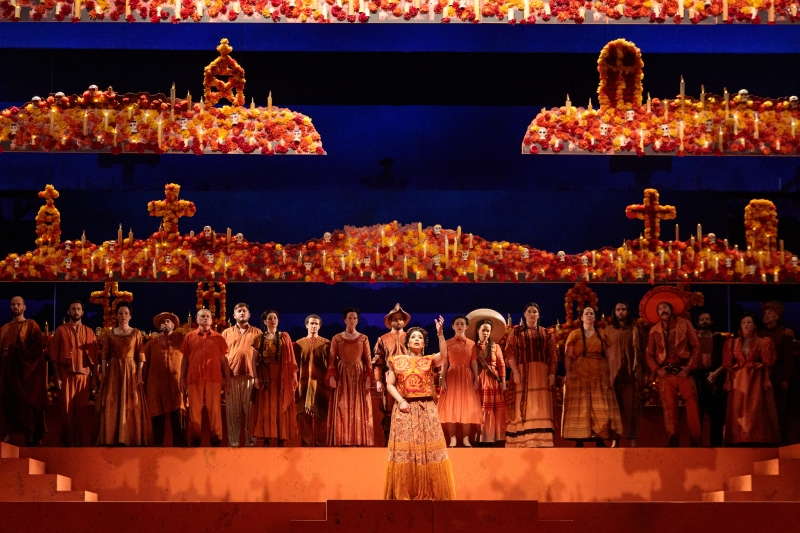
The Act I set of El último sueño de Frida y Diego. Photo © Karli Cadel
Set designer Jorge Ballina combined with fellow Mexicans costume designer Eloise Kazan and lighting director Victor Zapatero to create a stage filled with beautifully exciting colors reminiscent of Frida's art. The opening curtain reveals a multi-level stage with three strings of votive candles strung across it. In a clever touch, these were raised to signal the action had moved between the worlds of the living and the dead. The opening set of Act II was quite different, but again reminiscent of Frida's paintings. A varied colorful background showed playful shapes in solid colors.
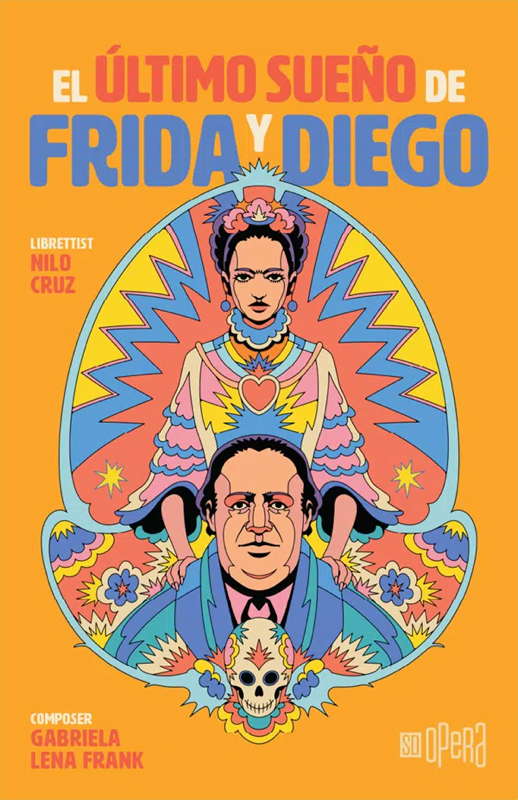
Publicity material for El último sueño de Frida y Diego
Frank's music and skilled orchestration featured her preferred mix of New and Old World, colorful and always fitting well with the changing emotions of Cruz's libretto. Conductor Roberto Kalb and San Diego Symphony musicians were in synch with the cast from beginning to end. The carefully built Act I orchestral climax was powerful and thrilling. And at the other extreme of emotional impact, bells and soft strings add to the poignant beauty of the opera's closing moments as the lovers enter a large wooden frame where they embrace, their love of each other and their art captured in a frozen moment of time.
Copyright © 4 November 2022
Ron Bierman,
San Diego, USA

GABRIELA LENA FRANK TALKS TO RON BIERMAN
SAN DIEGO CLASSICAL MUSIC ARTICLES


